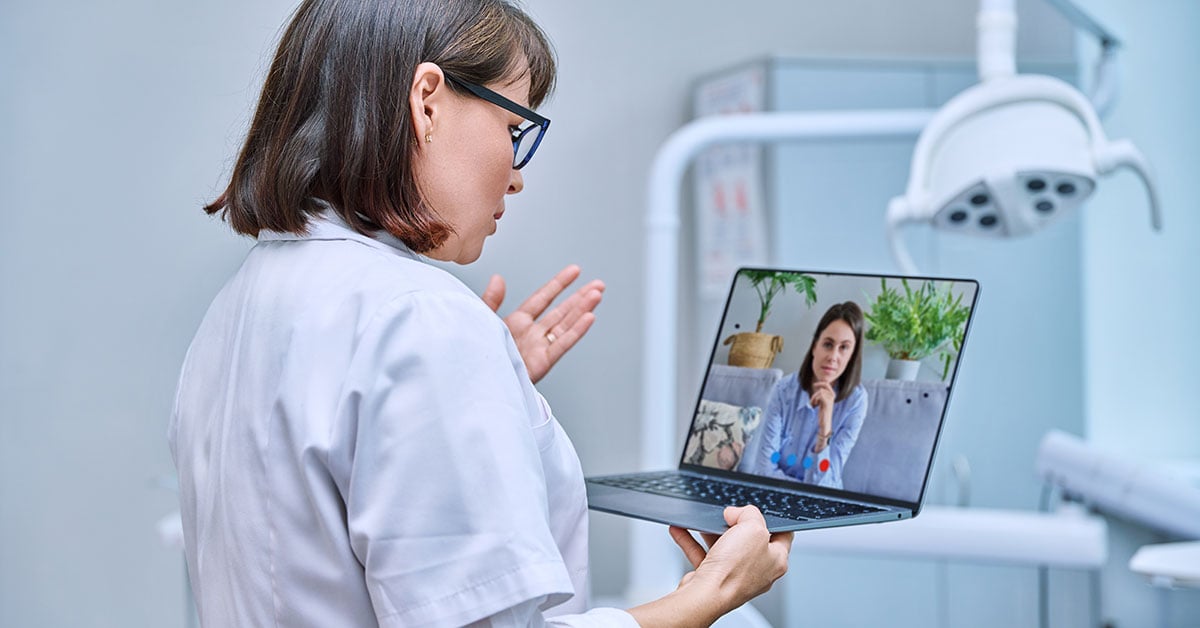There are compelling reasons for you to provide teledentistry to your patients. But those reasons also compel a number of questions - starting with why it’s necessary to obtain informed consent for teledentistry services.
The informing part is key for this emerging treatment protocol. Many patients are perhaps seeing the growing popularity of telehealth and telemedicine services. As a provider you bear the responsibility to inform them.
Policy protection
The American Dental Association (ADA) remains your policy guide for all things teledentistry. As it’s emerged as a viable approach to patient treatment they have helped define it for you and your patients.
”Teledentistry refers to the use of telehealth systems and methodologies in dentistry. Telehealth refers to a broad variety of technologies and tactics to deliver virtual medical, health, and education services. Telehealth is not a specific service, but a collection of means to enhance care and education delivery.”
In general, teledentistry includes:
- Live (synchronous) video interaction between you (the provider) and your patient via audio-visual technology
- Stored (asynchronous) information such as health information, digital images, digital impressions, etc forwarded for viewing and evaluation via a secure, electronic communications system
- Remote monitoring of your patients to provide supportive care
- Mobile health care via mobile communication devices for patient education, care support, etc
Documented protection
The proper documentation protects you and your patients when they choose a teledentistry appointment. A summary of the services they can expect with teledentistry is your first level of documentation.
Once you provide a thorough overview your patients can expect to be protected under certain informed consent guidelines.
- You as a dentist using teledentistry are licensed in the state that they are receiving your services. Or you are providing the services as one authorized by your state’s dental board.
- Patients can expect to have access to your licensure and board certification qualifications in advance of their appointment.
- Teledentistry services you provide will follow “evidence-based” practice guidelines as available. These guidelines will assure your patient’s safety, care quality, and positive health outcomes.
- Your patients will be informed about their provider’s identity relative to the information collected or evaluated and any treatment provided. All related costs they could incur will be clearly communicated in advance of services delivered.
- Relevant patient information will be obtained prior to the use of teledentistry technologies. Information includes medical, dental, social history, and other demographic and personal information.
- All teledentistry technology and related services will be documented. Records and documentation will be provided to your patient upon request.
- Teledentistry technology and services provided to your patient include care coordination as part of their home dental practice. Any other practice or entity - serving as their dental home - can also obtain those care records.
- Your patient(s) will be actively involved in treatment decisions and choose how they receive a “covered” service. Urgency, convenience, and satisfaction will be considered without penalties such as a deductible increase, co-payments, or co-insurance relative to that of in-person services.
- Teledentistry technologies and services will be subject to applicable laws and regulations regarding the privacy and security of your patient’s private health information.
 How to cover-your-bases with informed consent for teledentistry services
How to cover-your-bases with informed consent for teledentistry services
It’s recommended that you keep your consent form for teledentistry informative…yet simple! A sample form is available from the California Dental Association (CDA). Use it for guidance or adapt it for your own purposes - making sure you cover all required information for obtaining consent.
State the purpose of consent for teledentistry
Basically, it’s asking written permission to participate in a teledentistry consultation. It outlines a review of records via digital means, the potential for treatment recommendations, and that you may/may not require an in-person appointment.
Communicate what a teledentistry consultation is
Inform them that teledentistry is a safe, secure way of accessing your dental expertise without an in-office visit. Dedicated technology could be used to view digital images and other relevant health information. Clarify that the goal of their teledentistry appointment is to provide care recommendations.
Inform them about what happens during a teledentistry appointment
Their mouth or tooth condition may be examined by you (their provider), a registered dental assistant (RDA), a registered dental hygienist (RDH), or (as allowed by California) a registered dental hygienist in alternative practice (RDHAP). Dental records such as images or other relevant information could be obtained electronically.
Their personal dental, medical, and health related information might be discussed with other health professionals. This data could be shared via phone or stored-forwarded (asynchronous) technology.
A teledentistry consultation might require more than one appointment. And limited treatment could be provided by qualified and licensed professionals following the teledentistry appointment.
Discuss their risks, benefits, and alternatives
Teledentistry provides them access to you (a dentist) and additional dental information without requiring them to travel to a dental office or clinic. Inform you patient(s) that an in-office appointment for treatment could be necessary following a teledentistry consultation.
Their in-office treatment will often be due to a specific dental or medical reason. And their future dental care will rely on recommendations made during the teledentistry consultation.
The primary alternative to a teledentistry appointment would be an in-person consultation with you (the provider). Clarify that results cannot be guaranteed following any dental consultation or procedure.
Confirm their rights and related confidentiality
Teledentistry consultations are currently subject to federal and state laws regarding confidentiality. A separate document (Notice of Privacy Practices) can be provided to your patient that outlines how confidentiality applies to the information obtained or discussed during a teledentistry appointment.
Your patient’s rights extend to their right to choose or not choose participation in a teledentistry consultation any time before and/or during the consultation. Their right to future care or treatment is not affected by their acceptance or decline.
They also have the option to seek a dental consultation or treatment in a dental office at any time before or after the teledentistry consultation. Their rights extend as well to any injury that occurs as a result of procedures provided by the RDA, RDH, or (as applicable) the RDHAP. You (the dentist) will be notified and arrangements will be made for appropriate injury treatment or follow-up.
 No-hassle informed consent and more…
No-hassle informed consent and more…
A dedicated teledentistry platform can be equipped to facilitate the need for informed consent.
- Forms can be customized and uploaded for easy patient access and clear consent communication
- Patients can access and complete the required forms via a secure patient portal within the platform
- Patients can update their forms and medical history information when necessary within the portal
The overall holistic solutions within a dedicated teledentistry platform enables you to fully maximize your virtual patient interactions…leading to no-hassle, fully informed patient consent!
Teledentix is an innovative, turn-key teledentistry solution created by Virtual Dental Care. The all-in-one platform will enable you to adapt teledentistry to your patient care and extend your services beyond the walls of your dental practice…and improve your patient engagement in the process.
- Teledentix provides an easy-to-use video conferencing tool that’s secure, HIPAA compliant, and specific to dentistry.
- Teledentix Basic is a perfect starting point. Begin with a free trial and then transition to a very low monthly fee. You and your patients can join unlimited video conferences including screen-share, file-share, video-share, and real-time chat communications.
Contact us about Teledentix and discover how it streamlines the interaction between you and your patient around their dental care…including informed consent for teledentistry.



